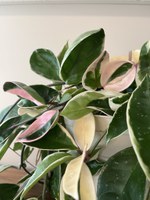Dakota Gardener: A hoya addition
(Click an image below to view a high-resolution image that can be downloaded)
By Carrie Knutson, Horticulture agent
NDSU Extension - Grand Forks County
Gardeners must give off the impression of being plant care takers. This has to be true, as I have been gifted one more houseplant. This makes four total in the past year. It is hard to say no to a plant, especially when it is a plant that you don’t have already.
My mother “gifted” me a very large hoya plant she received from a friend. She didn’t like the plant and wanted it out of her house. I was horrified for the plant’s fate and didn’t want it put in the dumpster. The plant is quite stunning. It has mainly white and green variegated foliage, but occasionally there are leaves with pink and green variegation. So, the plant made the trek to my office before the weather got cold.
Hoyas are sometimes called wax plants, wax vine or porcelain flower. They are in the same family as milkweed. There are a few hoya species in the houseplant industry, with many cultivars and varieties with different colors and leaf textures.
Hoyas are native to Australia and have thick leaves that are covered with a waxy layer. The waxy layer helps the leaves retain moisture. They have a vining growth habit and grow quite long. My rescued plant has long vines, six or more feet in length.
I did have to cut a vine as it grew through an eye hook on a wall hanging. It was a vine that had the pink coloration. Luckily, hoyas can be propagated by stem cuttings. My cutting is in a small vase of water with a new developing root.
Hoyas are described as an easy-care plant, as they are treated like a succulent. Hoyas like well-drained soil, so use a cactus or succulent potting soil mix. Keep the soil moist but not wet. If the leaves start to curl or have a limp appearance, it is time to water. Hoyas prefer bright indirect light and are slow growing.
Hoya flowers have a sweet smell and develop on the ends of vines. New hoya growers are warned not to trim off the bare vine ends, as flowers will form year after year from this area. I can’t wait for my hoya to flower. Happy gardening!
NDSU Agriculture Communication – Nov. 29, 2023
Source: Carrie Knutson, 701-780-8229, carrie.knutson@ndsu.edu
Editor: Kelli Anderson, 701-231-6136, kelli.c.anderson@ndsu.edu




